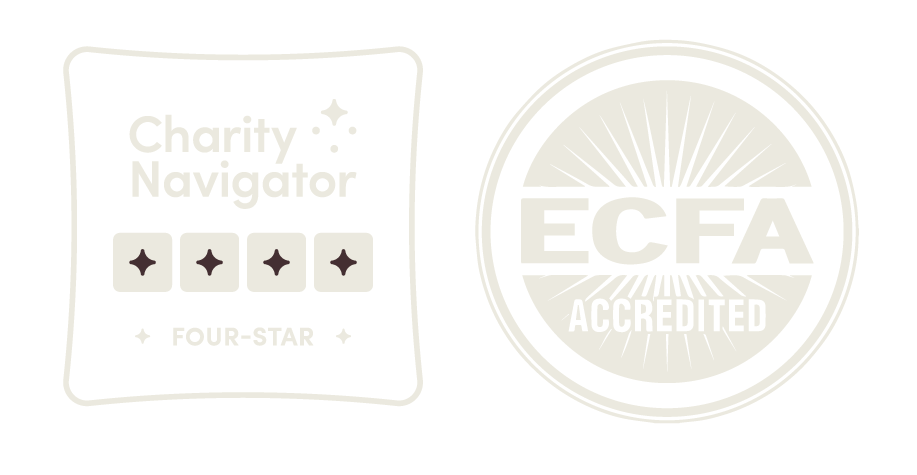The national electrical grid in Burundi (a small country in east-central Africa) has always given us some significant challenges both in terms of the quantity and the quality of the electrical power delivered to the nearby mission hospital.
There would be times when the hospital would receive only one hour of power per day from the national grid. And diesel, our only other alternative fuel source, was becoming extremely hard to find.
For instance, if diesel did become available at a gas station, say, 30km away – we had to first get a special letter from our Provincial Governor to allow us to buy a very limited quantity, and then race to the station before it was all gone. And the lines at these gas stations would sometimes reach one hundred cars long.
All of this meant that we had to cut way back on the number of hours we could provide power to the hospital, which had dramatic effects on patient care. Those who needed oxygen could not get it, premature babies were not able to be warmed in incubators, essential surgeries could not be performed, etc.
We were becoming hamstrung. Something had to be done.
Then in 2016, a group of electricians and solar experts working for a non-profit called International Technical Electric and Construction (I-TEC) visited our hospital when they were in the area, and asked if we had ever considered solar power for Kibuye Hope Hospital. This group of gentlemen immediately impressed us. They were professional, very knowledgeable, and delightful to have around.
In the following months, ITEC proposed a solution they call a Power Pac: a 40-foot container that they build out and pre-wire in their warehouse in Pennsylvania complete with batteries, inverters, and switchgear. The solar panels, distribution wire, and mounting equipment would be shipped in a separate container. Our team held many discussions about this solution and finally decided this was right for Kibuye.
Volunteers at ITEC spent countless man-hours throughout 2017 and early 2018 purchasing equipment, building and testing the Power Pac.
Then, in 2018, two shipping containers left Pennsylvania and traveled via New York City, the Atlantic Ocean, the Mediterranean Sea, the Suez canal, changed ships in India, went through the port of Dar es Salaam and then finally came by road to Burundi.
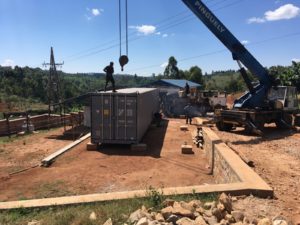 To our great relief, the containers arrived safely in early June. The Power Pac was set in place by two cranes, one of which must have been from the WW2 era.
To our great relief, the containers arrived safely in early June. The Power Pac was set in place by two cranes, one of which must have been from the WW2 era.
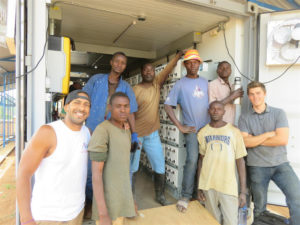
Just a few of the many helping hands that enabled this to happen.
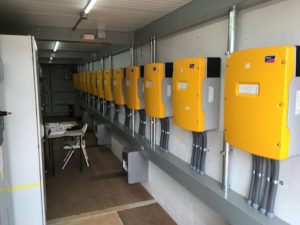 Inside the Power Pac: 15 battery inverters hang on the right side.
Inside the Power Pac: 15 battery inverters hang on the right side.
Photos by Caleb Fader
This amazing project, a collaboration by dozens of dedicated people, enabled us to have 24/7 power at the Kibuye Hope Hospital for the very first time.
In the first 14 months alone, we were able to have harvest just shy of 160 MWh of power from the sun – which is roughly equivalent to the average power consumption of 15 US homes over the same period. That’s a bit hard to wrap one’s head around!
But in rural Africa, you can always count on surprises and changes of plan. And you can always count on rain.
With long rainy days affecting our solar panels and the national diesel shortage crippling our ability to use a generator, we were often finding ourselves with no other choice but to use the national grid to power the hospital through a lot of nights.
Using the national grid power opens us up to ‘dirty power’, the kind that is unreliable and puts a lot of our electrical equipment at risk. Especially the sensitive and expensive equipment in the lab, radiology, operating rooms, eye unit, and our growing IT service.
But, luckily, my good friend in the US, Jason Kurien, who is an electrical engineer suggested we use a Power Conditioner – which is a really sophisticated electronic transformer that can take in “dirty power,” clean it up, and produce “clean power.” I had never heard of one, but it sounded like it could work.
So, our friends, Jesh and Julie Thiessen raised funds to buy a very large power conditioner to serve the whole hospital.
This unit ended up being about the size of a refrigerator – but at about double the weight – over 1,020kg or 2,250 lbs!
It’s heavy.
It’s fragile.
And very, very expensive.
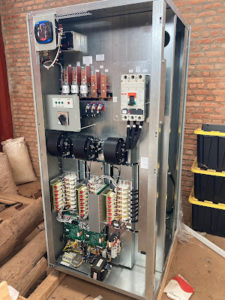 The Larger Power Conditioner: complex, expensive, and vital to the hospital.
The Larger Power Conditioner: complex, expensive, and vital to the hospital.
When the time came to install this wonderful piece of equipment, we only had one problem.
We needed to move it from our workshop to a very hard-to-reach area where the power enters our campus (about 500ft away over really rough terrain and down two 1-meter high ledges.)
How was this going to happen with the tools and resources we have?
It was my brother, and teammate, Jason’s idea to figure out a way to increase the number of hands we could get on it. And it was Desire, our master welder, who brought this idea to fruition.
We ended up with a system that would hopefully allow 30 men to carry the power conditioner safely without injury to man or machine. With all the steel, the men would need to be able to carry 35kg or 80 lbs. each.
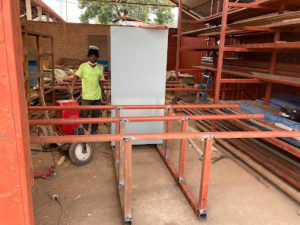
Desire, our master welder, welded up the carrying contraption.
I envisioned that we would just take our time and move 10 or 15 feet at a go and then gently put it down and rest. It would have been totally fine if it took all day.
But once those 30 men started moving there was no stopping them!
They even sang as they walked and their flip-flops were flying everywhere. They did end up putting it down one time en route, but that was only to get clarification on which direction it should face once they arrived at the concrete slab. It was quite a sight to behold.
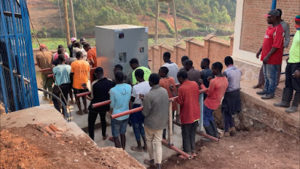
Arriving safely at the destination. Phew!!
Community development is often like the teamwork of the ancient Egyptians who built the great pyramids – thousands of people coming together – engineers, artists, skillful craftsmen, supervisors, and workers – to accomplish seemingly impossible tasks.
At the hospital, both of these projects have had a life-saving impact.
It means that oxygen concentrators can satisfy the endless demand, incubators for premature infants stay warm, lab results never have to wait, x-rays can be taken when needed, and surgical operations can happen at all hours of the day or night.
The impact of this collaborative work on the ability of Kibuye Hope Hospital to care for patients will surely be felt for years to come.
WATCH: See the story of how I-TEC brought clean energy to Kibuye, Burundi through solar power
Special Thanks:
We are very thankful to ITEC for their tireless effort in supporting this installation. And we are very grateful to many for their hand in the solar panel project:
Funding: African Mission Healthcare Foundation and the Christian Broadcasting Network, Isaiah Mission Foundation, David Pyott Foundation, Brenden and Jenece Hanks and a number of other generous individuals.
ITEC Volunteers: 28 men and women from North America who came and served this community with their skills and always did so with a smile.
Jack Myhre: Engineering Intern working at Kibuye for the summer did a vast majority of the site preparation planning and design.
———————
Are you interested in combining your skills and your heart for missions?
Here at Serge, we see community development as a tangible demonstration of God’s love. Our teams partner with local churches to advance community development projects, which ties our work to the love of Jesus, and places Him – not us – in the role of provider and Savior.
Areas of work include:
- Safe water projects
- Medical services and training
- Health programs for preventing disease
- Nutrition, health, and hygiene education
- Economic training
- Agricultural training
- Entrepreneurial training and business development



